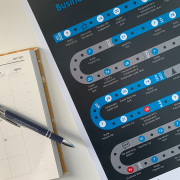
Some small business owners find themselves in the difficult position of running a business that appears to be profitable, but still having no money in the bank. It’s an important situation to address. After all, a lack of adequate cash flow is one of the main causes of small business failure.
Here are three reasons profitable businesses have little money in the bank, and what business owners can do to address these situations.
1. Using business money for personal reasons
Owners may be using their business bank account as a personal bank account, withdrawing the money as they see fit. Of course, business owners need to earn a living. Instead of using the business account like a personal account, entrepreneurs should give themselves a wage and transfer that from the business account to their personal account at set intervals. If their personal money runs out, they can’t go back to the business account for more money until their next withdrawal date.
Regular use of the business account, even for relatively small amounts, adds up and can have a drastic effect on a business’s cash flow.
2. Not collecting payments
Businesses need to make money, and they do so when customers pay their bills. Not sending out invoices in a timely manner, not following up when customers fail to pay and not conducting adequate credit checks on customers all put cash flow in jeopardy.
It’s best for business owners to send out invoices with clear payment terms and follow up immediately if customers violate those. They can also put procedures in place to avoid customers who are unlikely to pay for work done or to mitigate the damage if clients attempt to get away without paying. Requiring deposits, for example, are a great way to manage both cash flow and customers.
3. Not preparing for tax season
Many small business owners see taxes as something they can worry about later. Then tax season rolls around and they don’t have enough money set aside to pay the collector. In some cases, a business may have suddenly had a large profit increase but not increased the amount set aside for taxes.
Business owners must treat their taxes as a regular expense. Set money aside each month to pay taxes. If there is a drastic increase in profits, set aside even more money. Being prepared is far better than being caught with too little.
Final thoughts
There are steps business owners can take to ensure that their business makes a profit and has money in the bank. First, they should learn how to read and understand their balance sheet and debtors ledger. These show how much money is coming in and where it’s going. It also highlights which customers aren’t paying their bills.
Entrepreneurs should also avoid using the business bank account for personal expenses. Instead, they should pull a set amount of funds to their personal account and limit their personal expenses to that amount.
Finally, business owners must understand their liabilities. Liabilities affect how much cash is available for their business and even small liabilities add up quickly. Know how much is owed, how much is paid monthly and when those bills are due.
By keeping track of the money coming into their business and where it goes when it leaves, entrepreneurs can get a better handle on ensuring their business not only makes a profit but actually has money in the bank.
Got a question about your business? Let’s talk.
Be even more on top of business pitfalls
You’re a business that stays in tune with your finances to stay ahead. So does our newsletter, so come on board for more heads-up:










